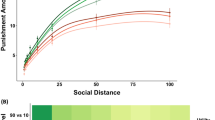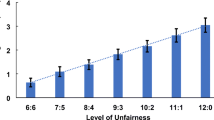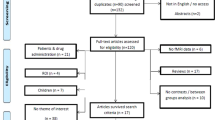Abstract
Second-party punishment (SPP) and third-party punishment (TPP) are two basic forms of costly punishment that play an essential role in maintaining social orders. Despite scientific breakthroughs in understanding that costly punishment is driven by an integration of the wrongdoers’ intention and the outcome of their actions, so far, few studies have compared the neurocognitive processes associated with the intention-outcome integration between SPP and TPP. Here, we combined economic exchange games measuring SPP and TPP with functional magnetic resonance imaging (fMRI) to compare the neuropsychological architectures underlying the intention-outcome integration during one-shot interactions with anonymous partners across four types of norm violations (no norm, accidental, attempted, and intentional violations). Our behavioral findings showed that third-parties punished only attempted norm violations less frequently than second-parties. Our neuroimaging findings revealed higher activities in the right temporoparietal junction (TPJ) and dorsolateral prefrontal cortex (dlPFC) for attempted norm violations during TPP relative to SPP; more activities in these regions with less punishment frequency; and enhancement of functional connectivity of the right TPJ with the right dlPFC and dorsomedial PFC. Our findings demonstrated specific psychological and neural mechanisms of intention-outcome interactions between SPP and TPP —helping to unravel the complex neurocognitive processes of costly punishment.




Similar content being viewed by others
Data availability
Data and experimental material are available upon reasonable request to the corresponding author.
Code availability
Code are available upon reasonable request to the corresponding author.
References
Alter, A. L., Kernochan, J., & Darley, J. M. (2007). Transgression wrongfulness outweighs its harmfulness as a determinant of sentence severity. Law and Human Behavior, 31(4), 319–335. https://doi.org/10.1007/s10979-006-9060-x
Ashton, M., & Lee, K. (2009). The HEXACO-60: A short measure of the major dimensions of personality. Journal of Personality Assessment, 91, 340–345. https://doi.org/10.1080/00223890902935878
Baumert, A., Schlösser, T., & Schmitt, M. (2014). Economic games: A performance-based assessment of fairness and altruism. European Journal of Psychological Assessment, 30(3), 178–192. https://doi.org/10.1027/1015-5759/a000183
Bellucci, G., Camilleri, J. A., Iyengar, V., Eickhoff, S. B., & Krueger, F. (2020). The emerging neuroscience of social punishment: Meta-analytic evidence. Neuroscience and Biobehavioral Reviews, 113, 426–439. https://doi.org/10.1016/j.neubiorev.2020.04.011
Brandstätter, H., & Königstein, M. (2020). Personality influences on ultimatum game bargaining decisions. European Journal of Personality, 15(S1), S53–S70. https://doi.org/10.1002/per.424
Büchel, C., Holmes, A., Rees, G., & Friston, K. (1998). Characterizing stimulus–response functions using nonlinear regressors in parametric fMRI experiments. Neuroimage, 8(2), 140–148.
Buckholtz, J. W., & Marois, R. (2012). The roots of modern justice: Cognitive and neural foundations of social norms and their enforcement. Nature Neuroscience, 15, 655–661. https://doi.org/10.1038/nn.3087
Buckholtz, J. W., Asplund, C. L., Dux, P. E., Zald, D. H., Gore, J. C., Jones, O. D., & Marois, R. (2008). The neural correlates of third-party punishment. Neuron, 60(5), 930–940. https://doi.org/10.1016/j.neuron.2008.10.016
Camerer, C. F. (2003). Behavioral game theory: Experiments in strategic interaction. Princeton University Press.
Civai, C., Corradi-Dell'Acqua, C., Gamer, M., & Rumiati, R. I. (2010). Are irrational reactions to unfairness truly emotionally-driven? Dissociated behavioural and emotional responses in the ultimatum game task. Cognition, 114(1), 89-95. https://doi.org/10.1016/j.cognition.2009.09.001.
Civai, C., Crescentini, C., Rustichini, A., & Rumiati, R. I. (2012). Equality versus self-interest in the brain: Differential roles of anterior insula and medial prefrontal cortex. Neuroimage, 62(1), 102–112. https://doi.org/10.1016/j.neuroimage.2012.04.037
Civai, C., Huijsmans, I., & Sanfey, A. G. (2019). Neurocognitive mechanisms of reactions to second- and third-party justice violations. Scientific Reports, 9(1), 9271. https://doi.org/10.1038/s41598-019-45725-8
Cremers, H. R., Wager, T. D., & Yarkoni, T. (2017). The relation between statistical power and inference in fMRI. PLoS One, 12(11), e0184923. https://doi.org/10.1371/journal.pone.0184923
Crockett, M. J., Özdemir, Y., & Fehr, E. (2014). The value of vengeance and the demand for deterrence. Journal of Experimental Psychology: General, 143(6), 2279–2286. https://doi.org/10.1037/xge0000018.supp
Davis, M. H. (1980). A multidimensional approach to individual differences in empathy. JSAS Catalog of Selected Documents in Psychology, 10, 85.
Eklund, A., Nichols, T. E., & Knutsson, H. (2016). Cluster failure: why fMRI inferences for spatial extent have inflated false-positive rates. Proceedings of the National Academy of Sciences, 201602413. https://doi.org/10.1073/pnas.1602413113
Fehr, E., & Fischbacher, U. (2004a). Social norms and human cooperation. Trends in Cognitive Sciences, 8(4), 185–190. https://doi.org/10.1016/j.tics.2004.02.007
Fehr, E., & Fischbacher, U. (2004b). Third-party punishment and social norms. Evolution and Human Behavior, 25(2), 63–87. https://doi.org/10.1016/S1090-5138(04)00005-4
Fehr, E., & Gächter, S. (2002). Altruistic punishment in humans. Nature, 415(6868), 137–140. https://doi.org/10.1038/415137a
Feng, C., Luo, Y. J., & Krueger, F. (2014). Neural signatures of fairness-related normative decision making in the ultimatum game: A coordinate-based meta-analysis. Human Brain Mapping, 36(2), 591–602. https://doi.org/10.1002/hbm.22649
Feng, C., Azarian, B., Ma, Y., Feng, X., Wang, L., Luo, Y. J., & Krueger, F. (2017). Mortality salience reduces the discrimination between in-group and out-group interactions: A functional MRI investigation using multi-voxel pattern analysis. Human Brain Mapping, 38(3), 1281–1298. https://doi.org/10.1002/hbm.23454
Feng, C., Zhu, Z., Gu, R., Wu, X., Luo, Y. J., & Krueger, F. (2018). Resting-state functional connectivity underlying costly punishment: A machine-learning approach. Neuroscience, 385, 25–37. https://doi.org/10.1016/j.neuroscience.2018.05.052
Fetchenhauer, D., & Huang, X. (2004). Justice sensitivity and distributive decisions in experimental games. Personality and Individual Differences, 36(5), 1015–1029. https://doi.org/10.1016/S0191-8869(03)00197-1
Friston, K. J., Buechel, C., Fink, G., Morris, J., Rolls, E., & Dolan, R. (1997). Psychophysiological and modulatory interactions in neuroimaging. Neuroimage, 6, 218–229.
Frith, C. D., & Frith, U. (2006). The neural basis of mentalizing. Neuron, 50(4), 531–534. https://doi.org/10.1016/j.neuron.2006.05.001
Ginther, M. R., Bonnie, R. J., Hoffman, M. B., Shen, F. X., Simons, K. W., Jones, O. D., & Marois, R. (2016). Parsing the behavioral and brain mechanisms of third-party punishment. The Journal of Neuroscience, 36(36), 9420–9434. https://doi.org/10.1523/JNEUROSCI.4499-15.2016
Gitelman, D. R., Penny, W. D., Ashburner, J., & Friston, K. J. (2003). Modeling regional and psychophysiologic interactions in fMRI: The importance of hemodynamic deconvolution. Neuroimage, 19(1), 200–207. https://doi.org/10.1016/S1053-8119(03)00058-2
Gospic, K., Mohlin, E., Fransson, P., Petrovic, P., Johannesson, M., & Ingvar, M. (2011). Limbic justice--amygdala involvement in immediate rejection in the ultimatum game. PLoS Biology, 9(5), e1001054. https://doi.org/10.1371/journal.pbio.1001054
Guroglu, B., van den Bos, W., Rombouts, S. A., & Crone, E. A. (2010). Unfair? It depends: Neural correlates of fairness in social context. Social Cognitive and Affective Neuroscience, 5(4), 414–423. https://doi.org/10.1093/scan/nsq013
Hoffman, M. (2014). The Punisher's brain: The evolution of judge and jury (T. Kuran & P. Boettke, Eds. 1 ed.). Cambridge University press.
Hu, J., Li, Y., Yin, Y., Blue, P. R., Yu, H., & Zhou, X. (2017). How do self-interest and other-need interact in the brain to determine altruistic behavior? Neuroimage, 157, 598–611. https://doi.org/10.1016/j.neuroimage.2017.06.040
Jordan, J. J., Hoffman, M., Bloom, P., & Rand, D. G. (2016). Third-party punishment as a costly signal of trustworthiness. Nature, 530(7591), 473–476. https://doi.org/10.1038/nature16981
Krueger, F., & Hoffman, M. (2016). The emerging neuroscience of third-party punishment. Trends in Neurosciences, 39(8), 499–501. https://doi.org/10.1016/j.tins.2016.06.004
Leibbrandt, A., & López-Pérez, R. (2012). An exploration of third and second party punishment in ten simple games. Journal of Economic Behavior & Organization, 84(3), 753–766. https://doi.org/10.1016/j.jebo.2012.09.018
Lieberman, M. D., & Cunningham, W. A. (2009). Type I and type II error concerns in fMRI research: Re-balancing the scale. Social Cognitive and Affective Neuroscience, 4(4), 423–428. https://doi.org/10.1093/scan/nsp052
Marlowe, F. W., Berbesque, J. C., Barrett, C., Bolyanatz, A., Gurven, M., & Tracer, D. (2011). The 'spiteful' origins of human cooperation. Proceedings of the Biological Sciences, 278(1715), 2159–2164. https://doi.org/10.1098/rspb.2010.2342
McLaren, D. G., Ries, M. L., Xu, G., & Johnson, S. C. (2012). A generalized form of context-dependent psychophysiological interactions (gPPI): A comparison to standard approaches. Neuroimage, 61(4), 1277–1286.
Mothes, H., Enge, S., & Strobel, A. (2016). The interplay between feedback-related negativity and individual differences in altruistic punishment: An EEG study. Cognitive, Affective, & Behavioral Neuroscience, 16(2), 276–288. https://doi.org/10.3758/s13415-015-0388-x
Nash, K., Gianotti, L. R., & Knoch, D. (2014). A neural trait approach to exploring individual differences in social preferences. Frontiers in Behavioral Neuroscience, 8, 458. https://doi.org/10.3389/fnbeh.2014.00458
Patil, I., Young, L., Sinay, V., & Gleichgerrcht, E. (2017). Elevated moral condemnation of third-party violations in multiple sclerosis patients. Social Neuroscience, 12(3), 308–329. https://doi.org/10.1080/17470919.2016.1175380
Rand, D. G., Fudenberg, D., & Dreber, A. (2015). It's the thought that counts: The role of intentions in noisy repeated games. Journal of Economic Behavior & Organization, 116, 481–499. https://doi.org/10.1016/j.jebo.2015.05.013
Sanfey, A. G., Rilling, J. K., Aronson, J. A., Nystrom, L. E., & Cohen, J. D. (2003). The neural basis of economic decision-making in the ultimatum game. Science, 300(5626), 1755–1758. https://doi.org/10.1126/science.1082976
Schmitt, M., Baumert, A., Gollwitzer, M., & Maes, J. (2010). The justice sensitivity inventory: Factorial validity, location in the personality facet space, demographic pattern, and normative data. Social Justice Research, 23(2), 211–238. https://doi.org/10.1007/s11211-010-0115-2
Schurz, M., Tholen, M. G., Perner, J., Mars, R. B., & Sallet, J. (2017). Specifying the brain anatomy underlying temporo-parietal junction activations for theory of mind: A review using probabilistic atlases from different imaging modalities. Human Brain Mapping, 38(9), 4788–4805. https://doi.org/10.1002/hbm.23675
Seymour, B., Singer, T., & Dolan, R. (2007). The neurobiology of punishment. Nature Reviews. Neuroscience, 8(4), 300–311. https://doi.org/10.1038/nrn2119
Smith, S. M., & Nichols, T. E. (2009). Threshold-free cluster enhancement: Addressing problems of smoothing, threshold dependence and localisation in cluster inference. Neuroimage, 44(1), 83–98. https://doi.org/10.1016/j.neuroimage.2008.03.061
Stallen, M., Rossi, F., Heijne, A., Smidts, A., De Dreu, C. K. W., & Sanfey, A. G. (2018). Neurobiological mechanisms of responding to injustice. The Journal of Neuroscience, 38(12), 2944–2954. https://doi.org/10.1523/JNEUROSCI.1242-17.2018
Strang, S., & Park, S. Q. (2017). Human cooperation and its underlying mechanisms. Current Topics in Behavioral Neurosciences, 30, 223–239. https://doi.org/10.1007/7854_2016_445
Strobel, A., Zimmermann, J., Schmitz, A., Reuter, M., Lis, S., Windmann, S., & Kirsch, P. (2011). Beyond revenge: Neural and genetic bases of altruistic punishment. Neuroimage, 54(1), 671–680. https://doi.org/10.1016/j.neuroimage.2010.07.051
Treadway, M., Buckholtz, T. J., Martin, J. W., Jan, K., Asplund, C. L., Ginther, M. R., Jones, O. D., & Marois, R. (2014). Corticolimbic gating of emotion-driven punishment. Nature Neuroscience, 17(9), 1270–1277. https://doi.org/10.1038/nn.3781
van’t Wout, M., Kahn, R. S., Sanfey, A. G., & Aleman, A. (2006). Affective state and decision-making in the ultimatum game. Experimental Brain Research, 169(4), 564–568. https://doi.org/10.1007/s00221-006-0346-5
Wang, Z., Xia, C. Y., Meloni, S., Zhou, C. S., & Moreno, Y. (2013). Impact of social punishment on cooperative behavior in complex networks. Scientific Reports, 3, 3055. https://doi.org/10.1038/srep03055
Yang, Q., Shao, R., Zhang, Q., Li, C., Li, Y., Li, H., & Lee, T. (2019). When morality opposes the law: An fMRI investigation into punishment judgments for crimes with good intentions. Neuropsychologia, 127, 195–203. https://doi.org/10.1016/j.neuropsychologia.2019.01.020
Young, L., & Saxe, R. (2008). The neural basis of belief encoding and integration in moral judgment. Neuroimage, 40(4), 1912–1920. https://doi.org/10.1016/j.neuroimage.2008.01.057
Young, L., & Saxe, R. (2009a). An fMRI investigation of spontaneous mental state inference for moral judgment. Journal of Cognitive Neuroscience, 21(7), 1396–1405. https://doi.org/10.1162/jocn.2009.21137
Young, L., & Saxe, R. (2009b). Innocent intentions: A correlation between forgiveness for accidental harm and neural activity. Neuropsychologia, 47(10), 2065–2072. https://doi.org/10.1016/j.neuropsychologia.2009.03.020
Young, L., Camprodon, J. A., Hauser, M., Pascual-Leone, A., & Saxe, R. (2010). Disruption of the right temporoparietal junction with transcranial magnetic stimulation reduces the role of beliefs in moral judgments. Proceedings of the National Academy of Sciences of the United States of America, 107(15), 6753–6758. https://doi.org/10.1073/pnas.0914826107
Yu, H., Li, J., & Zhou, X. (2015). Neural substrates of intention--consequence integration and its impact on reactive punishment in interpersonal transgression. The Journal of Neuroscience, 35(12), 4917–4925. https://doi.org/10.1523/JNEUROSCI.3536-14.2015
Zhao, K., & Smillie, L. D. (2015). The role of interpersonal traits in social decision making: Exploring sources of behavioral heterogeneity in economic games. Personality and Social Psychology Review, 19(3), 277–302. https://doi.org/10.1177/1088868314553709
Zhen, S., & Yu, R. (2016). Tend to compare and tend to be fair: The relationship between social comparison sensitivity and justice sensitivity. PloS one, 11(5), 11(5), e0155414. https://doi.org/10.1371/journal.pone.0155414
Zhong, S., Chark, R., Hsu, M., & Chew, S. H. (2016). Computational substrates of social norm enforcement by unaffected third parties. Neuroimage, 129, 95–104. https://doi.org/10.1016/j.neuroimage.2016.01.040
Zhou, Y., Jiao, P., & Zhang, Q. (2016). Second-party and third-party punishment in a public goods experiment. Applied Economics Letters, 24(1), 54–57. https://doi.org/10.1080/13504851.2016.1161709
Funding
C.F. was supported by the National Natural Science Foundation of China (31900757, 32020103008) and Natural Science Foundation of Guangdong Province (2021A1515010746). Q.Y. was supported by The cultivation project (19JYXK016) of the province leveled preponderant characteristic discipline in the school of education at Hangzhou normal university.F.K. was supported by the German Academic Exchange Service (DAAD).
Author information
Authors and Affiliations
Contributions
F.K. and S.L. conceived and designed the experiment; C.F. analyzed the data; C.F., Q.Y., and F.K. interpreted the results and wrote the paper; C.F., Q.Y., F.K, L.A., K.A., R.G., W.L., M.H., and S.L. revised the paper.
Corresponding authors
Ethics declarations
Ethical approval
The study was approved by the Ethics Committee of University of Mannheim.
Consent to participate
Written informed consents were obtained from all participants.
Consent for publication
Authors have read and approved the final version of the manuscript.
Conflict of interest
The authors are unaware of any conflicts of interest, financial or otherwise.
Additional information
Publisher’s note
Springer Nature remains neutral with regard to jurisdictional claims in published maps and institutional affiliations.
Stefanie Lis and Frank Krueger Joint Senior Authorship
Rights and permissions
About this article
Cite this article
Feng, C., Yang, Q., Azem, L. et al. An fMRI investigation of the intention-outcome interactions in second- and third-party punishment. Brain Imaging and Behavior 16, 715–727 (2022). https://doi.org/10.1007/s11682-021-00555-z
Accepted:
Published:
Issue Date:
DOI: https://doi.org/10.1007/s11682-021-00555-z




